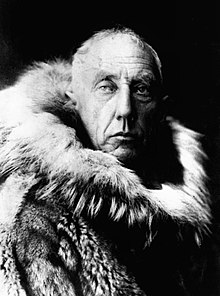Roald Amundsen | |
|---|---|
 Amundsen c. 1923 | |
| Born | Roald Engelbregt Gravning Amundsen 16 July 1872[1] Borge, Østfold, Norway |
| Disappeared | 18 June 1928 (aged 55) Barents Sea |
| Occupation | Explorer |
| Known for |
|
| Awards |
|
| Signature | |
Roald Engelbregt Gravning Amundsen (UK: /ˈɑːmʊndsən/, US: /-məns-/;[3][4] Norwegian: [ˈrùːɑɫ ˈɑ̂mʉnsən] ; 16 July 1872 – c. 18 June 1928) was a Norwegian explorer of polar regions. He was a key figure of the period known as the Heroic Age of Antarctic Exploration.
Born in Borge, Østfold, Norway, Amundsen began his career as a polar explorer as first mate on Adrien de Gerlache's Belgian Antarctic Expedition of 1897–1899. From 1903 to 1906, he led the first expedition to successfully traverse the Northwest Passage on the sloop Gjøa. In 1909, Amundsen began planning for a South Pole expedition. He left Norway in June 1910 on the ship Fram and reached Antarctica in January 1911. His party established a camp at the Bay of Whales and a series of supply depots on the Barrier (now known as the Ross Ice Shelf) before setting out for the pole in October. The party of five, led by Amundsen, became the first to reach the South Pole on 14 December 1911.
Following a failed attempt in 1918 to reach the North Pole by traversing the Northeast Passage on the ship Maud, Amundsen began planning for an aerial expedition instead. On 12 May 1926, Amundsen and 15 other men in the airship Norge became the first explorers verified to have reached the North Pole.[5][6] Amundsen disappeared in June 1928 while flying on a rescue mission for the airship Italia in the Arctic. The search for his remains, which have not been found, was called off that September.
- ^ "Østfold county, Borge in Borge, Parish register (official) nr. I 6 (1861–1874), Birth and baptism records 1872, page 114". Archived from the original on 6 October 2013. Retrieved 25 July 2012.
- ^ "Den kongelige norske Sanct Olavs Orden", Norges Statskalender (in Norwegian), 1910, pp. 907–08, archived from the original on 17 November 2021, retrieved 17 November 2021 – via hathitrust.org
- ^ "Amundsen, Roald" (US) and "Amundsen, Roald". Lexico UK English Dictionary. Oxford University Press. Archived from the original on 7 November 2021.
- ^ "Amundsen". Merriam-Webster.com Dictionary. Merriam-Webster. Retrieved 7 March 2019.
- ^ Cite error: The named reference
whowasfirstatthenorthpolewas invoked but never defined (see the help page). - ^ Cite error: The named reference
flyingtothenorthpolewas invoked but never defined (see the help page).